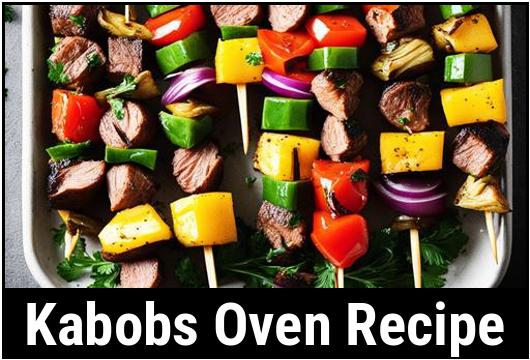
Kabobs Oven Recipe: A Culinary Delight Meets Science
Kabobs are more than just a meal; they encompass a culinary experience that brings together flavors, textures, and aromas in a delightful skewered presentation. While traditionally cooked over an open flame, the oven offers a convenient alternative to enjoy these mouthwatering delights. In this comprehensive guide, we will delve into the intricacies of kabobs, exploring food science, culinary details, selection, cleaning, preparation, tips, variations, doneness checks, and even the nuances of overcooking and undercooking. So, tie on your apron and get ready for a flavorful journey!
The Science Behind the Perfect Kabob
Before we begin exploring every aspect of kabobs, it’s essential to understand the science behind achieving the perfect cooking results. Understanding the principles of heat transfer and protein denaturation can significantly enhance your kabob endeavors.
Heat in the oven is transferred through convection, making it essential to arrange your kabobs in a way that maximizes air circulation. For even cooking, ensure there is enough space between each skewer while ensuring the oven’s heat distribution is uninterrupted.
Protein denaturation is a crucial process that transforms the texture and taste of kabobs. The high heat exposure prompts proteins to unravel, creating a tender and juicy interior while forming a flavorful crust on the exterior. Achieving the right balance between caramelization and moisture retention is key.
Selecting the Perfect Ingredients
To create a truly mouthwatering kabob, it all begins with selecting the right ingredients. Freshness, texture, and flavor compatibility play pivotal roles in the success of your dish.
1. Protein Choices:
Immerse yourself in a world of tantalizing flavors by choosing from a variety of proteins. The most popular kabob proteins include:
-
Chicken: Boneless chicken breasts or thighs offer a juicy and versatile choice.
-
Beef: Tender cuts like sirloin, rib-eye, or filet mignon provide succulent envelopes of flavor.
-
Lamb: Tender and slightly gamey, cuts like leg or loin are perfect for a unique kabob experience.
-
Seafood: Shrimp and fish kabobs, such as salmon or mahi-mahi, introduce a delightful twist.
2. Vegetable Medley:
Adding a vibrant palate of vegetables to your kabobs enhances both visual appeal and taste. Opt for bell peppers, onions, cherry tomatoes, zucchini, and mushrooms for a diverse range of flavors.
3. Marination Marvels:
Marinades infuse your kabobs with deep flavors while adding moisture. Create your marinade using a combination of acid (lemon juice, vinegar, yogurt), oil, spices, and herbs. Allow the proteins to marinate for at least 30 minutes, or overnight for intensified flavor.
Cleaning and Preparing Your Skewers
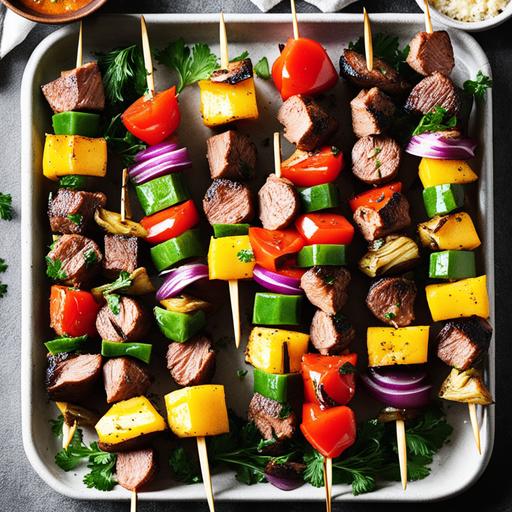
Before you embark on your kabob adventure, it’s essential to prepare your skewers adequately.
1. Soak Your Bamboo Skewers:
If you opt for bamboo skewers, soaking them in water for at least 30 minutes is crucial. This prevents scorching and splintering during oven cooking.
2. Metal Skewers: A Reliable Alternative
Metal skewers offer durability and eliminate the need for soaking. Stainless steel or other heat-resistant metal skewers provide an excellent choice for those wanting a reusable option.
3. Assemble with Care:
When assembling your kabobs, alternate between protein and vegetable pieces for even cooking. Leaving some room at each end of the skewer allows for secure handling during cooking and serving.
Tips for an Enjoyable Kabob Experience
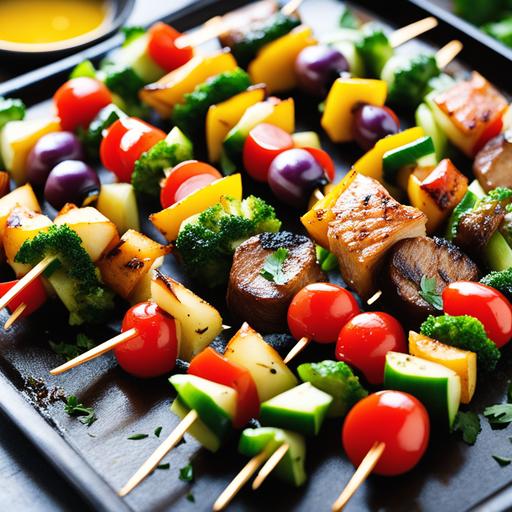
Preparing kabobs might seem like an intimidating endeavor, but fear not! The following tips will pave the way for a successful and enjoyable kabob experience:
1. Mindful Cooking Times:
Different proteins require different cooking times in the oven. For example, beef may take around 12-15 minutes at 400°F (205°C) for medium-rare, while chicken might require 15-20 minutes at 375°F (190°C) until fully cooked. Keep a close eye on your kabobs to avoid overcooking or undercooking.
2. Basting Brilliance:
To keep your kabobs moist and intensify flavors, baste them periodically during the cooking process. Brush on your marinade or a mixture of melted butter, herbs, and spices. Basting both at the beginning and near the end achieves a delectable glaze.
3. Enhancing Smoky Flavors:
To infuse your oven-baked kabobs with a touch of smokiness, consider adding a few wood chips or herbs to a smoking pouch. Place the pouch directly on the oven rack, allowing the gentle smoke to envelop your kabobs with aromatic richness.
Options and Variations to Delight Your Palate
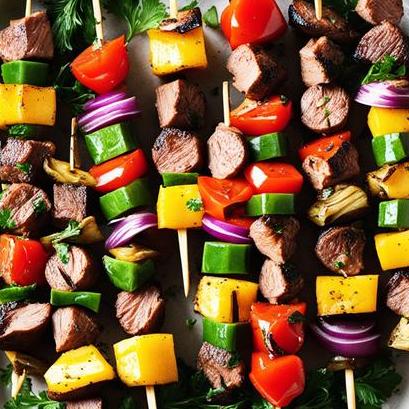
The versatility of kabobs extends beyond the traditional protein and vegetable combinations. With a creative mindset, you can experiment with various flavors and presentations to make every meal unique. Here are a few options to get your culinary imagination flowing:
1. Global Inspirations:
Explore a variety of marinades inspired by different cuisines, such as teriyaki, tandoori, or chimichurri. These unique flavors will transport your taste buds to different corners of the world.
2. Fruit Infusions:
Introduce a sweet and tangy twist by incorporating fruits like pineapple, peaches, or apricots on your kabobs. Grilling them alongside the proteins and vegetables caramelizes their natural sugars, providing a delightful burst of flavors.
3. Seafood Extravaganza:
Expand your kabob repertoire by experimenting with a selection of seafood delights. Scallops, lobster tail, or even squid can bring a taste of the ocean to your kabob party.
Checking the Doneness of Your Kabobs
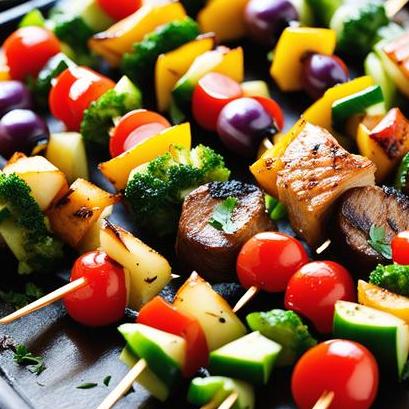
Knowing the signs that your kabobs are perfectly cooked ensures a phenomenal dining experience for you and your guests.
1. Thermometer Accuracy:
Investing in a reliable instant-read meat thermometer is fundamental. Different proteins have different safe internal temperatures, so make sure you familiarize yourself with the appropriate readings.
2. Color Guidance:
While not always foolproof, the color of the protein can provide some indication of doneness. Chicken should have no pink in the center, beef can be cooked to preference (ranging from rare to well-done), and lamb should have a slightly rosy hue in the center.
3. Texture Tells:
A firm and slightly springy texture indicates properly cooked proteins, while rubbery or overly soft textures might signify undercooked or overcooked kabobs, respectively.
A Classic Kabob Recipe: Oven Style
Now that we have explored the world of kabobs in great detail, it’s time to put our newfound knowledge into practice. Here’s a classic kabob recipe that will have your taste buds dancing with joy:
Ingredients:
-
1 pound (450g) boneless chicken breasts, cubed
-
1 red bell pepper, cut into chunks
-
1 green bell pepper, cut into chunks
-
1 red onion, cut into chunks
-
8 cherry tomatoes
-
8 bamboo or metal skewers
Marinade:
-
⅓ cup (80ml) olive oil
-
2 tablespoons lemon juice
-
2 garlic cloves, minced
-
1 tablespoon paprika
-
1 teaspoon cumin
-
1 teaspoon dried oregano
-
1 teaspoon salt
-
½ teaspoon black pepper
Instructions:
-
Soak bamboo skewers in water for at least 30 minutes or use metal skewers.
-
In a bowl, whisk together all marinade ingredients until well combined.
-
Place chicken cubes in a ziplock bag and pour the marinade over them. Seal and gently toss to coat the chicken evenly. Refrigerate for at least 30 minutes or overnight.
-
Preheat your oven to 400°F (205°C) and line a baking sheet with aluminum foil.
-
Thread the marinated chicken, bell peppers, red onion, and cherry tomatoes onto the skewers, alternating between ingredients for even cooking.
-
Place the skewers on the prepared baking sheet, ensuring they are not touching each other.
-
Bake in the preheated oven for 12-15 minutes or until the chicken is cooked through, reaching an internal temperature of 165°F (74°C).
-
Baste the kabobs with the remaining marinade or your favorite sauce during the last 5 minutes of cooking for extra flavor and moisture.
-
Remove the kabobs from the oven and let them rest for a few minutes before serving alongside your favorite sides.
The Fine Line Between Overcooking and Undercooking
While mastering the art of cooking kabobs in the oven, it is essential to understand the potential pitfalls of both overcooking and undercooking.
1. Overcooking Woes:
Leaving your kabobs in the oven for too long can lead to dry and tough proteins. To avoid disappointment, regularly monitor the internal temperature with a meat thermometer and keep your cooking times in check.
2. The Perils of Undercooking:
Undercooked kabobs pose a food safety risk as they may contain harmful pathogens. Ensure that each protein reaches the appropriate safe internal temperature to protect yourself and your loved ones.
In Summary: Enjoy the Delectable Journey of Kabobs
From understanding the science behind the perfect kabob to exploring ingredient selections, cleaning and preparation tips, and variations that surprise the palate – this comprehensive guide has provided an in-depth look into the world of kabobs.
Remember, kabobs offer endless possibilities for culinary creativity, ensuring each meal is a unique experience. Whether using the oven for convenience or embracing the smoky flavors of grilling, the art of kabob making invites you to savor every bite. So, gather your ingredients, fire up your oven, and embark on a flavorful journey that will have everyone asking for seconds!
Sources
FAQS On Kabobs Oven Recipe
What Type Of Meat Is Best For Making Kabobs In The Oven?
For kabobs in the oven, you can use a variety of meats such as chicken, beef, lamb, or even shrimp. Just make sure to cut the meat into evenly sized pieces so they cook evenly.
What Are Some Good Marinades For Kabobs In The Oven?
Some popular marinade options for kabobs in the oven include a simple mixture of olive oil, lemon juice, and herbs, or a more flavorful blend of soy sauce, ginger, and garlic. Marinating the meat for at least 1-2 hours before cooking will help enhance the flavor.
How Long Does It Take To Cook Kabobs In The Oven?
The cooking time for kabobs in the oven will depend on the type of meat and the size of the pieces. Generally, it takes about 15-20 minutes to cook chicken or beef kabobs, and slightly less time for shrimp. It’s important to check the internal temperature of the meat to ensure it’s fully cooked.
Can I Use Vegetables On The Kabobs As Well?
Yes, vegetables such as bell peppers, onions, zucchini, and cherry tomatoes can be added to the kabobs for extra flavor and color. Just make sure to cut the vegetables into uniform pieces so they cook evenly alongside the meat.
Do I Need To Soak Wooden Skewers Before Using Them In The Oven?
Yes, if you’re using wooden skewers, it’s a good idea to soak them in water for at least 30 minutes before using them. This helps prevent the skewers from burning during the cooking process. If you’re using metal skewers, there’s no need to soak them.



